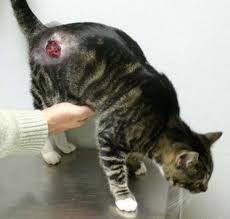 Feline Leukemia Virus (WFC, FeLV, or from the English. Feline leukemia virus) – this is a well-known killer. FeLV weakens the immune system and also has a direct impact on the development of cancer in infected cats. This disease is considered the most dangerous infection in cats, resulting in death.
Feline Leukemia Virus (WFC, FeLV, or from the English. Feline leukemia virus) – this is a well-known killer. FeLV weakens the immune system and also has a direct impact on the development of cancer in infected cats. This disease is considered the most dangerous infection in cats, resulting in death.
Although there is a vaccine against this deadly disease, they do not always give a positive result. As in the case of FIV, the best way to protect your cat from leukemia – to do the appropriate tests and to protect it from infected animals. Ideally, this means to keep her indoors only, one or the other, also non-infected cats.
Do tests to all new cats or kittens before bringing them into his house, where there are other cats. (Prior to vaccinate an animal, at first he in any case, do an analysis on the FeLV.) Your cats should also make the tests again after they have been in contact with potential carriers of FeLV, especially if your cat is bitten. Symptoms vary FeLV, so sick cat should be tested for FeLV. Cats walking on the street, or those who have been in contact with potential carriers of FeLV, testing should be done annually.
Most vets do a combined analysis for FIV and FeLV, which allows to determine the presence of both of these viral diseases with one blood sampling.
FeLV – this is very serious. Do not allow yourself to succumb to self-pity and take home a cat, she is not making pre-analysis on FeLV, especially if you are already living in the house of other cats. By doing so, you may be putting at risk the lives of their pet cats. But if it did happen and you find that allowed their contact with domestic cats FeLV-infected animals, do not panic. Isolate from infected their cats and take them to tests in accordance with the instructions of a veterinarian. After a contact transmission can not occur. Sometimes it takes a long time and repeated contact. So hope for the best and avoid further contact.
But what if analysis on your cat has FeLV was positive? The first thing you must understand that being a carrier of the virus does not mean to be sick. Some, in other respects healthy cats with a positive response to FeLV, live for months or even years without any symptoms of the disease. If an infected cat is the only thing your pet, the following guidelines. First, do not let her out, she was unable to infect other cats, as well as pick up any infections from them. Second, spend all the necessary preventive measures, the cat is not sick with something else, and collaborate with your veterinarian to diagnose and cure time associated with any FeLV disease that can develop in cats.
Most often the disease occurs in the form of lymphosarcoma, in particular the thymus. At the same time by progressive atrophy of the thymus and increases immunosuppression, neutropenia is detected. Sometimes the disease is in the form of myeloid leukemia. Sick cats are particularly susceptible to the virus to others, as well as to bacterial and fungal infections.
Symptoms. Cat exhausted, say fever, anorexia, lethargy, pallor of mucous membranes, glossitis, stomatitis, frequent breast cancer, glomerulonephritis, skin disease (demodicosis, sarcoptic mange), secondary infection. Signs of immune deficiency anemia, decreased hematocrit, atrophy of the thymus, and lymph nodes.
There are several options of the disease:
approximately 30% of the body produces antibodies, and the animal overcomes the viral infection;
40% of asymptomatic carriage is possible FeLV – these cats are the most dangerous source of infection of other cats, but eventually most of them due to the progressive destruction of immune system is developing one of the diseases peculiar to leukemia virus;
30% – a viral infection leads to severe neoplastic diseases of the lymphoid organs (lymphoma, lymphosarcoma).
In the diagnosis of particular importance is the identification of serum viral antigen p27 by using solid-phase enzyme immunoassay method (ELISA) and immunofluorescence analysis. According to recent data, a crucial role in determining the outcome of FeLV-infection in vaccinated cats or animals recovering from illness, acquired in a natural way to play a FeLV-specific cytotoxic T lymphocytes.
In contrast to FIV, FeLV virus can be defeated by the immune system of many cats. It is therefore important in two to three months after receiving (and confirmation) of a positive analysis for FeLV do retested.
You must be logged in to post a comment.